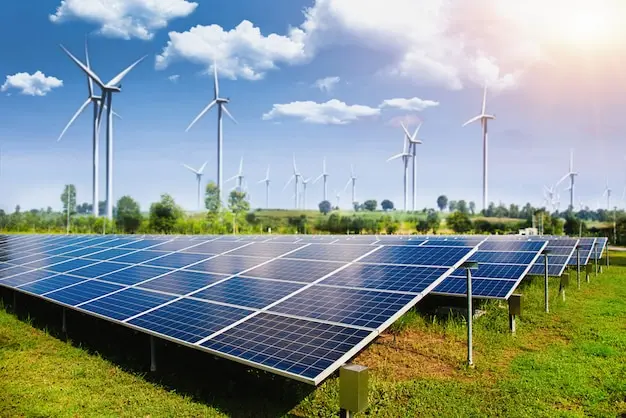In the face of increasing environmental concerns and the urgent need to mitigate climate change, the terms “sustainable” and “renewable” have become buzzwords in the energy sector. However, while these terms are often used interchangeably, they carry distinct meanings that are crucial to our understanding of how we can better harness and manage our energy resources.
This article aims to shed light on the difference between sustainable and renewable energy, two concepts that are at the heart of the global discourse on climate change and the future of our planet. Whether you’re a newly married couple looking to power your first home, a young environmentalist passionate about sustainable living, or simply someone keen on understanding the future of energy, this guide is for you.
We’ll delve into the various sources of renewable energy, from the power of the wind and sun to the untapped potential of hydropower. We’ll also explore the concept of sustainable energy, a term that goes beyond mere resource replenishment and delves into the long-term impact of our energy consumption patterns.
By understanding the difference between these two terms, we can make informed decisions about our energy use, advocate for policies that promote both renewable and sustainable energy, and contribute to a future where energy is not just abundant, but also kind to our planet and future generations.
Stay with us as we embark on this enlightening journey into the world of sustainable and renewable energy.
Key Takeaways
- While all sustainable energy is renewable, not all renewable energy is sustainable. The key difference lies in the impact on the environment and society.
- Sustainable energy meets our present needs without compromising the ability of future generations to meet their own needs. It is environmentally friendly, economically viable, and socially responsible.
- The younger generation, newlyweds, new homeowners, sustainable living enthusiasts, and environmentalists all have a role to play in promoting sustainable energy.
- The future of energy is not only renewable but also sustainable. This involves continuous innovation, policy implementation, and education about sustainable energy.
Understanding Renewable Energy
Renewable energy, as the name suggests, comes from sources that are naturally replenished and virtually inexhaustible in the human timeframe. These include energy derived from the sun, wind, water and the internal heat of the Earth.
Solar Power: The sun is our most abundant source of energy. Solar power harnesses the energy of the sun’s rays to generate electricity. It’s a clean, green, and increasingly affordable source of power that can be used in everything from powering homes and businesses to charging electric vehicles.
Wind Power: Wind power utilizes the kinetic energy of the wind to turn turbines and generate electricity. It’s a clean and sustainable form of energy that, much like solar power, is seeing a surge in popularity and usage across the globe.
Hydropower: Hydropower, or water power, is generated by using the force of flowing or falling water. It’s the most mature and widely-used form of renewable energy, accounting for a significant portion of the world’s renewable energy production.
Geothermal Power: Geothermal power taps into the Earth’s internal heat to generate electricity. It’s a reliable and constant source of power that doesn’t depend on the weather, making it a valuable part of any renewable energy strategy.
While renewable energy sources are naturally replenished, it’s important to note that the rate of replenishment and the methods of harnessing these resources can have varying impacts on the environment. This brings us to the concept of sustainable energy, which takes into account not just the source of the energy, but also the long-term implications of its use.
Understanding Sustainable Energy
Sustainable energy is a concept that goes beyond the source of energy itself. It is about harnessing and utilizing energy in ways that meet our present needs without compromising the ability of future generations to meet their own needs. This means that sustainable energy sources are not only naturally replenished, but they are also harnessed and used in a manner that is environmentally friendly, economically viable, and socially responsible.
For instance, while a hydroelectric dam uses a renewable source (water), the construction and operation of the dam could lead to significant environmental disruption, displacement of local communities, and changes to aquatic ecosystems. In such a case, despite the renewable nature of the source, the energy produced may not be considered sustainable due to these adverse impacts.
On the other hand, solar and wind power, when implemented with careful planning and consideration for local ecosystems, can be both renewable and sustainable. They produce no harmful emissions during operation, require no fuel other than sunlight or wind, and their impact on the environment and local communities can be minimal.
The Intersection of Renewable and Sustainable Energy
The intersection of renewable and sustainable energy is where we find the most promising solutions for our energy future. These are energy sources and systems that are not only replenished naturally but also designed and managed in ways that minimize harm to the environment, support social equity, and are economically viable.
For example, community solar projects can provide local, renewable energy that benefits the entire community, supports local jobs, and reduces environmental impact. Similarly, wind farms, when properly sited to minimize the impact on wildlife and local communities, can provide large amounts of renewable energy while contributing to local economies.
The Difference Between Sustainable and Renewable Energy
While all sustainable energy is renewable, not all renewable energy is sustainable. The key difference lies in the impact on the environment and society.
Renewable energy sources like wind, solar, and hydropower are naturally replenished and can provide us with a virtually unlimited supply of energy. However, the methods of harnessing and utilizing these sources can sometimes lead to environmental and social challenges. For instance, large solar farms can require extensive land use, and hydropower plants can disrupt aquatic ecosystems and local communities.
On the other hand, sustainable energy not only considers the renewability of the source but also the long-term impacts of energy production and use. Sustainable energy solutions aim to minimize environmental harm, support social equity, and maintain economic viability. They consider the entire lifecycle of energy production, from the extraction of resources to the disposal of waste.
Sustainable Energy for Newly Married Persons and New Home Owners
As newly married persons or new homeowners, embracing sustainable energy can have numerous benefits. Not only can it help reduce your environmental footprint, but it can also lead to significant cost savings in the long run.
Solar panels on your roof, for instance, can provide a renewable source of energy that is also sustainable. They require little maintenance, produce no emissions during operation, and can even generate excess energy that you can feed back into the grid for a credit on your energy bill.
Similarly, choosing energy-efficient appliances and implementing energy-saving measures at home, such as proper insulation and smart thermostats, can go a long way in reducing your energy consumption and making your home more sustainable.
Sustainable Energy for Sustainable Living Enthusiasts
For those passionate about sustainable living, understanding the difference between renewable and sustainable energy is crucial. It’s not just about using renewable energy, but about using it in a way that is sustainable for the environment, the economy, and society.
This could mean advocating for and supporting renewable energy projects that prioritize environmental and social well-being, such as community solar projects or responsibly-sited wind farms. It could also mean taking steps in your own life to reduce your energy consumption, such as by improving energy efficiency at home or choosing green transportation options.
Sustainable Energy for the Younger Generation
The younger generation has a vital role to play in the transition towards more sustainable and renewable energy. As future leaders, innovators, and consumers, understanding the difference between these two concepts can guide informed decisions and actions that will shape the energy landscape of the future.
Education is a powerful tool in this regard. By learning about different energy sources and their impacts, young people can become advocates for sustainable energy in their schools, communities, and eventually, in their professional lives. They can also influence change at home, by encouraging energy-saving habits and perhaps even inspiring their families to consider renewable energy options like solar power.
Moreover, the younger generation can drive demand for sustainable energy by choosing to support businesses that prioritize sustainability. In a world increasingly defined by climate change, the actions and voices of the younger generation are more important than ever.
Sustainable Energy for Environmentalists
For environmentalists, the shift towards sustainable and renewable energy is not just a matter of reducing greenhouse gas emissions. It’s about promoting an energy system that respects and works in harmony with nature, rather than against it.
This means advocating for energy projects that take into account their impact on local ecosystems and biodiversity. It means pushing for stricter regulations on harmful energy practices, and supporting research and development into new, more sustainable energy technologies.
Environmentalists can also lead by example, by implementing sustainable energy solutions in their own lives and communities. This could be as simple as installing solar panels on their homes, participating in a community wind project, or even starting a local initiative to promote energy efficiency.
The Future of Sustainable and Renewable Energy
The future of energy is one that is not only renewable but also sustainable. As we move forward, it’s crucial that we continue to innovate and improve our methods of harnessing and using energy, always with an eye toward sustainability.
This means investing in research and development of new technologies, from more efficient solar panels and wind turbines to advanced energy storage solutions. It means implementing policies that encourage the adoption of sustainable energy and discourage harmful energy practices. And most importantly, it means educating ourselves and others about the importance of sustainable energy, and how each of us can contribute to a more sustainable energy future.
Conclusion
Understanding the difference between sustainable and renewable energy is more than just a matter of semantics. It’s about recognizing the impact of our energy choices on the world around us and making decisions that support a healthier, more sustainable future. Whether you’re a newlywed, a new homeowner, a sustainable living enthusiast, a member of the younger generation, or an environmentalist, we all have a role to play in this important endeavor.
Frequently Asked Questions (FAQs)
-
Does renewable energy mean sustainable?
While all sustainable energy is renewable, not all renewable energy is sustainable. The sustainability of energy not only considers the renewability of the source but also the long-term impacts of energy production and use on the environment, economy, and society.
-
What is an example of renewable and sustainable energy?
Solar and wind energy are examples of energy sources that can be both renewable and sustainable. They are naturally replenished and, when harnessed and used responsibly, can have minimal impact on the environment and society.
-
What is sustainable but not renewable?
Certain practices using non-renewable energy sources can be considered sustainable if they are used efficiently and responsibly, and if efforts are made to minimize their environmental impact. For instance, a highly energy-efficient building powered by natural gas could be considered more sustainable than an inefficient building powered by renewable energy.

